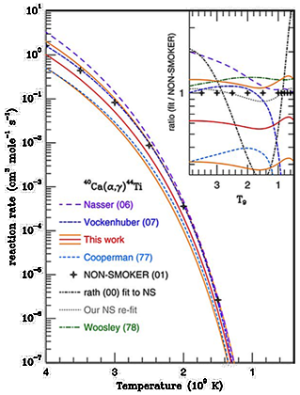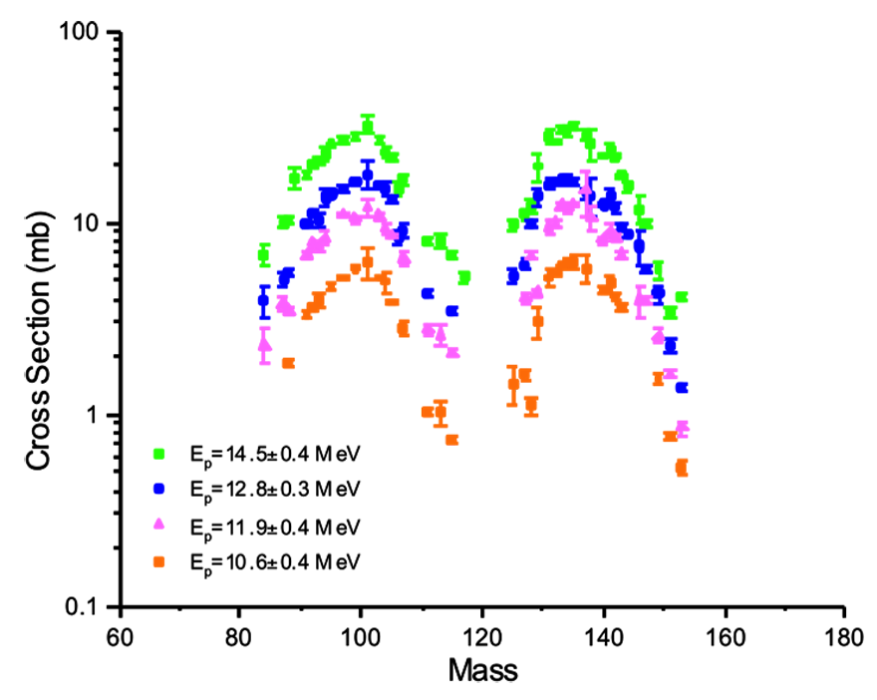Nuclear Physics
The 10-MV tandem accelerator at CAMS provides a platform for conducting nuclear physics experiment both for basic science and lab mission-related programs.
For example, we performed a new cross section measurement of the astrophysically important reaction 40Ca(a,g)44Ti in which high purity CaO targets were irradiated with helium ions at several different discrete energies. The reaction rate was measured on-line via prompt gamma ray spectroscopy and validated by post-irradiation measurement of 44Ti at a low-level counting facility.
The relatively high beam currents available at CAMS (He2+ ~3 uA) enabled measurement of this cross section to better than 1% statistical uncertainty in a matter of several hours. The results of this experiment play an important role in constraining the nucleosynthesis models used to predict the distribution of elements produced in stars [Figure 1].
The offline counting portion of the 40Ca(a,g)44Ti experiment described above is an example of a direct measurement of a nuclear cross section. Direct measurements provide particularly valuable experimental data because they do not rely on theoretical model calculations that introduce intrinsic uncertainty into an evaluated cross section. For example, existing data for the 239Pu(n,2n)238Pu cross section at energies <14 MeV are largely inferred from measurements of a handful of partial g-ray cross sections coupled with Hauser-Feshbach model calculations. The unique capabilities of CAMS offer the potential to validate existing model-dependent data by directly measuring the 238Pu/239Pu atom ratio in irradiated samples.
Radiochemistry
The ion irradiation capabilities at CAMS constitute an important tool for experimental radiochemistry at LLNL. By bombarding targets with intense beams of high-energy light ions (e.g., 1H, 2H, 4He, etc.), we induce nuclear reactions that yield radioactive species that can be used for a wide range of applications including tracers for development of radiochemical separation methods and diagnostic monitors for assessing the efficiency of shots at the LLNL National Ignition Facility (NIF). Co-location with CAMS is an important feature to the LLNL radiochemistry program because it provides access to short-lived activation products that are not widely-available from off-site sources.
Another important radiochemical application of CAMS is the production of realistic samples for nuclear forensic exercises. As part of this effort, we recently performed an improved measurement of the energy-dependent cross sections from proton-induced fission of 238U [Fig. 2]. This data will enable us to design future irradiations to produce mixtures of fission and activation products that will simulate the debris from a nuclear explosion. By carefully selecting the projectile/target combination we will be able to produce samples that are both realistic but also completely unfamiliar to radiochemists who participate in nuclear forensics exercises, thus creating a more challenging scenario for the exercise.
Selected Reference
Hoffman RD, Sheets SA, Burke JT, Scielzo ND, Rauscher T, Norman EB, Tumey S, Brown TA, Grant PG, Hurst AM, Phair L, Stoyer MA, Wooddy T, Fisker JL, and Bleuel D. (2010) Reaction Rate Sensitivity of 44Ti Production in Massive Stars and Implications of a Thick Target Yield Measurement of 40Ca(α, γ)44Ti. The Astrophysical Journal 715:1383–1399






